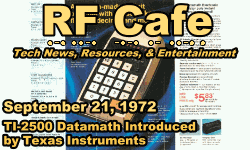 September 21 September 21
 1853: Dutch physicist
Heike Kamerlingh Onnes, who discovered superconductivity, was
born. 1866: H.G.
Wells, of War of the Worlds fame, was born. 1895: The
Duryea Motor Wagon Company became the first auto manufacturer
in America. 1895:
Juan de la Ciervra, inventor of the autogiro, was born. 1897:
The New York Sun ran a famous editorial that answered a question from 8-year-old
Virginia O'Hanlon: ''Is there a Santa Claus?'' 1913: The first aerobatic maneuvers
were publicly performed by
Adolphe Pégoud
in his Blériot
XI. 1921:
Donald Glaser,, who won the Nobel Prize for his invention of the
bubble chamber for observing subatomic particles, was born. 1931: Britain abandoned
the gold standard. 1936:
Frank Hornby,
English toy manufacturer who patented the Meccano construction set, died. 1942: The
B-29 Superfortress made its maiden flight. 1955: Britain annexed
the islet of
Rockall, 300 miles west of Scotland, to stop the Soviets spying
on missile tests. 1961:
Earle Dickson,
inventor of the Band-aid, died. 1972: Texas Instruments announced the
TI-2500,
the TI-3000,
and the TI-3500
DATAMATH calculators. 2003: The NASA Galileo space probe ended its eight-year mission to Jupiter as
planned. 1853: Dutch physicist
Heike Kamerlingh Onnes, who discovered superconductivity, was
born. 1866: H.G.
Wells, of War of the Worlds fame, was born. 1895: The
Duryea Motor Wagon Company became the first auto manufacturer
in America. 1895:
Juan de la Ciervra, inventor of the autogiro, was born. 1897:
The New York Sun ran a famous editorial that answered a question from 8-year-old
Virginia O'Hanlon: ''Is there a Santa Claus?'' 1913: The first aerobatic maneuvers
were publicly performed by
Adolphe Pégoud
in his Blériot
XI. 1921:
Donald Glaser,, who won the Nobel Prize for his invention of the
bubble chamber for observing subatomic particles, was born. 1931: Britain abandoned
the gold standard. 1936:
Frank Hornby,
English toy manufacturer who patented the Meccano construction set, died. 1942: The
B-29 Superfortress made its maiden flight. 1955: Britain annexed
the islet of
Rockall, 300 miles west of Scotland, to stop the Soviets spying
on missile tests. 1961:
Earle Dickson,
inventor of the Band-aid, died. 1972: Texas Instruments announced the
TI-2500,
the TI-3000,
and the TI-3500
DATAMATH calculators. 2003: The NASA Galileo space probe ended its eight-year mission to Jupiter as
planned.
| Jan
| Feb | Mar |
Apr | May |
Jun | Jul |
Aug | Sep |
Oct | Nov |
Dec |
Note: These
historical tidbits have been collected from various sources, mostly on the Internet.
As detailed in
this article, there
is a lot of wrong information that is repeated hundreds of times because most websites
do not validate with authoritative sources. On RF Cafe, events with
hyperlinks have been verified. Many years ago,
I began commemorating the birthdays of notable people and events with
special RF Cafe logos.
Where available, I like to use images from postage stamps from the country where
the person or event occurred. Images used in the logos are often from open source
websites like Wikipedia, and are specifically credited with a hyperlink back to
the source where possible.
Fair Use laws permit
small samples of copyrighted content.
|








 September 21
September 21
